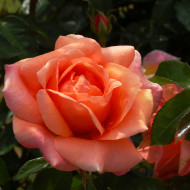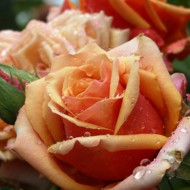How to grow a spectacular Cherry Brandy rose: planting and care secrets
Content
Breeding history
Crop production was carried out in the famous European rose center Rosen Tantau, organized at the beginning of the last century in Germany. They took as a basis the hybrid tea varieties of the same nursery that existed at that time, and in 2001 success was achieved. After another 3 years, the roses were presented to the general public at an official exhibition, after which their sale began.
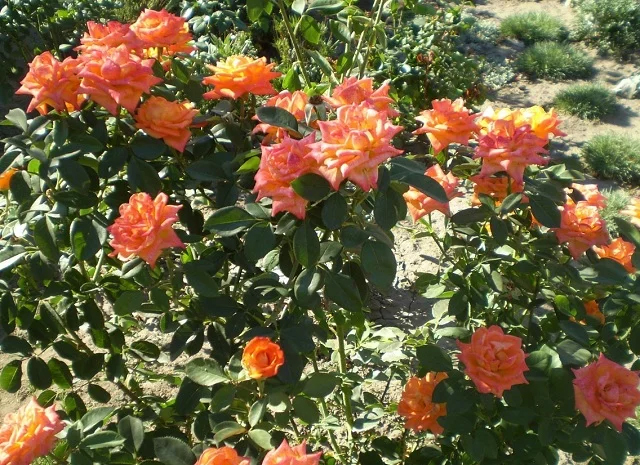
Description of hybrid tea rose
The breeders managed to give their brainchild a number of useful technical characteristics, first of all - the complete absence of thorns on the shoots, which is important for bouquets. Here is a detailed description of the hybrid:
- A vigorous variety, the height of a strong stem is up to 1 m.
- The crown of the bush is compact, branching is small.
- The foliage is dense, leathery, green, textured, looks decorative.
- The buds are massive (up to 10 cm in diameter), densely double, formed from 45 petals. On the peduncle, they are located one by one or grouped into inflorescences up to 5 pieces. The inner petals have a wavy outline, resembling a fringe.
- The flower is goblet, retains its density when opened. The color of the petals is variegated: from the inside it is apricot-yellow, like copper, from the outside it is closer to light orange. The color of the outlines is richer, with a garnet tint.
- The aroma is weak, but palpable, there are fruity and honey tints, reminiscent of the smell of cherry liqueur.
Since the founders of Cherry Brandy were the pink varieties of the Rosen-Tantau center, it is worth saying a few words about them:
- Cherry Brandy 1966. This is the first hybrid. Today the variety is rarely found on the market, but it is in demand among true collectors. Outwardly similar to the described specimen, but there are a number of differences - the petals are light orange, the aroma is strong, the buds are clearly smaller, formed from 17-25 petals, semi-double.
- Cherry Brandy 1985. To this day, the hybrid is in demand on the market and among gardeners around the world. The main differences of the variety from the modern version are that the bush is taller, larger, the foliage is lighter, the buds are formed from 30–35 petals, the waviness of the contours is weak, rather scalloped.
At first comparison, the 1985 Cherry Brandy flowers are more massive than their 1966 predecessors, but less lush than the new cultivar.
Technical features of the 2004 hybrid rose:
- good immunity to common flower diseases;
- easy care, feasible for beginners;
- high frost resistance - in temperate climates it needs partial pruning for the winter, when the buds freeze, it is easily restored with the arrival of heat;
- the flowering season lasts from mid-summer to autumn frosts;
- photophilous, rains do not spoil the appearance;
- the buds open slowly and at different times, several times per season, so the view of the bushes is always picturesque.
- 2004 Cherry Brandy
- 1985 Cherry Brandy
- 1966 Cherry Brandy
Advantages and disadvantages of the variety
The attractiveness of culture for gardeners and florists is expressed in the following positive aspects.
- resistance to rain - buds and petals do not lose their lush appearance;
- long growing season, abundant flowering;
- drought and cold resistance;
- immunity to fungal and infectious diseases;
- long-term preservation of the appearance in the cut.
- with general light-requiring, the petals quickly fade in the sun. It is necessary to plant a crop in places half-covered by a shadow falling from tall shrubs and trees;
- average winter hardiness. Colds down to –10 ° C will not harm the plants, short-term, stronger frosts, too, but shelter still does not hurt.
Video "Description of the Rose Cherry Brandy"
By watching this video, you will have an idea of what the Cherry Brandy variety looks like.
Growing conditions
The ideal time for planting rose bushes is considered to be the beginning of May, when the ground has warmed up enough and the threat of late frosts has passed. In the south, it is permissible to plant in autumn, in mid-latitudes - in March.
Requirements for choosing a suitable site:
- Fertile soil with good drainage with pH 5.6–7.3. Nutrient soil is purchased in a specialized store or made independently by mixing 3 measures of manure, 2 measures of sand and turf soil, 1 measure of peat.
- The air should warm up to + 15–25 ° С.
- Water should not stagnate in the selected area. Roses love moisture, but not excessive moisture, otherwise the roots will rot.
- Good ventilation, but no drafts or cold winds.
The site should have good lighting and warmth by the sun, but partial shade is desirable after lunch. In heavily shaded areas, flowering becomes weaker.
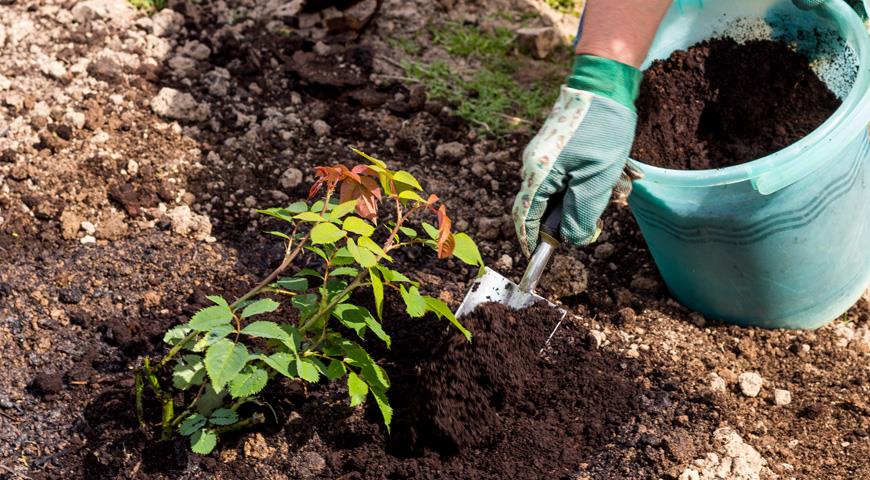
Planting and leaving
The agrotechnology of planting varieties is no different from the rules for planting pink crops. The algorithm is as follows:
- In the prepared area, a hole is dug 50-60 cm deep, the width is enough to completely spread the roots of the seedling. When planting several bushes, a distance of 50 cm is maintained between the holes.
- The bottom is drained with fine gravel, pebbles or fragments of bricks mixed with sand.
- The seedling is placed in the center of the hole, covered with prepared fertile soil.
- Mulch with bark or dust.
- Water it abundantly - it is necessary for the moisture to reach the very roots.
Watering the planted bushes is carried out 2 times a week, 1 bucket per bush. The water should be settled, not cold, preferably warm. On dry days, watering is doubled, making sure that the soil does not dry out and moisture does not stagnate.

Although culture is undemanding, it needs to be cared for. The care is as follows:
- Top dressing. In April, nitrogen compounds will be needed, urea or saltpeter will do (dilute 1 tbsp. L. Per 10 l). In July, they take phosphorus-potassium fertilizers to enhance flowering. In September, they are fed with magnesium-potassium.
- Loosening and soil maintenance. Weeding is done once a week to get rid of weeds and oxygenate the soil.
- Formative pruning. In the first year, the branches are shortened, leaving 3-4 buds (about 15 cm from the surface). This enhances the formation of the lower shoots. If the soil is too light (sandstone) or contains little nutrients, pruning is minimized to 5-6 buds. In subsequent years, strong and moderate pruning alternates depending on growth: powerful shoots are shortened to 4 buds (20 cm), others - up to 2-3. With age, you will have to cut 2-3 stems annually.
- Prevention of pests and diseases. Diseases attack the culture in the spring, therefore preventive treatment is desirable. When the shelter is removed, the bushes are examined. If bugs or fungi are found, they are sprayed with the appropriate fungicides or insecticides, capturing the soil around the bush.
By winter, the bush is cut off and treated with a copper-containing preparation.Then they are covered with spruce branches, fallen leaves and wrapped in burlap. This will allow the bush to survive frosts down to –30 ° С.
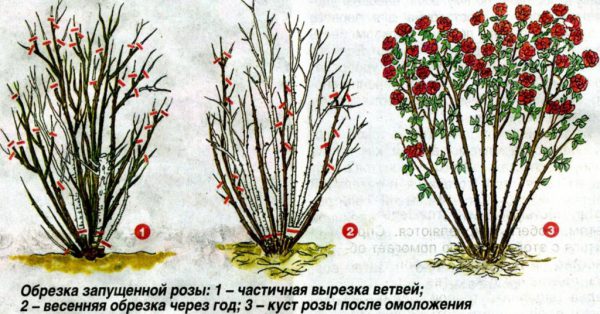
The most common problem faced by beginners is the lack of buds on the bushes. What can be done in such a situation:
- wait - if the seedlings are young, they need time to take root;
- transplant the bush to a more sunny or less windy place;
- feed with formulations that stimulate flowering;
- cut off shoots or remove blooming buds so that they do not pull extra juices;
- adjust watering, loosen the ground more often.
Use cases in landscape design
Rose Brandy Cherry belongs to cut crops, therefore they are poorly suited for decorating garden landscapes. In the garden, they combine well with other flowers, but they look better in a solitary planting, since not all cultures can compete with their unique colors.
They can be planted as a hedge, to decorate garden compositions - reservoirs and alpine slides. Single bushes look good at the central entrance, porch or near an open terrace.
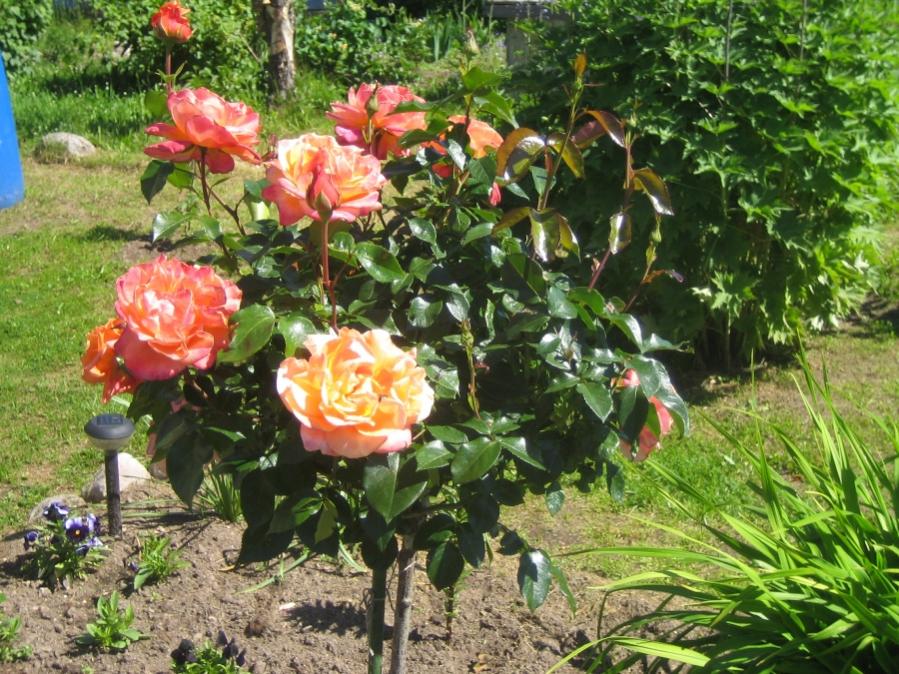
Reviews of gardeners about the variety
“I have been dealing with Brandy Cherry roses for over 5 years. Pleases and flowering and long vitality. Twice there were problems - aphids and powdery mildew, coped easily. I recommended it to my neighbors - the reviews are grateful. "
“In my area, the variety picks up black spot a lot, although there is plenty of sun and feeding. It freezes over the winter, but then recovers perfectly. Blooms all summer very colorfully and magnificently, for which I forgive him all my troubles. "
“In our region, it burns out a lot even under the autumn sun. I planted it in an open area and this is the problem. We need a shade, not strong, rather a partial shade. I spray it against fungi, because the black spot is minimal. "
Cherry Brandy roses are worth all the effort spent growing. As a result, a picturesque decoration blooms in the garden, delighting the owners for many years.


